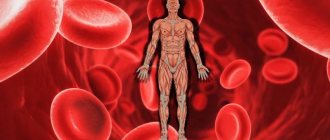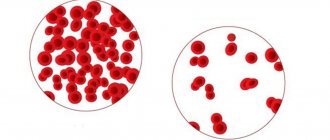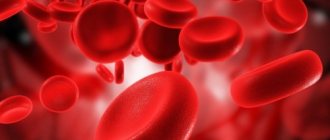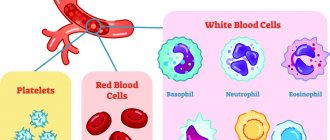Hemolytic anemia - what it is, clinical recommendations and treatment methods
Hemolytic anemia (HA) is a series of rare, but diagnosable and treatable blood diseases, during which increased destruction of red blood cells begins. HA, which is caused by intravascular destruction, appears as a result of the action of toxins, severe burns, blood poisoning, and transfusion of blood that is inappropriate for the rhesus group and blood type. Immunopathological processes also influence.
HA with extravascular (intracellular) destruction is hereditary in nature. The destruction of red blood cells occurs more often in the macrophages of the spleen, less often in the bone marrow, liver and lymph nodes. Probably a trio: anemia, inflammation of the spleen and jaundice. HA are divided into erythrocytopathies, erythrocytoenzymopathies and hemoglobinopathies.
A little about red blood cells
Erythrocytes, or red blood cells, are blood cells whose main function is to transport oxygen to organs and tissues.
- Red blood cells are formed in the red bone marrow, from where their mature forms enter the bloodstream and circulate throughout the body. The lifespan of red blood cells is 100-120 days. Every day, about 1% of them die and are replaced by the same number of new cells.
- If the lifespan of red blood cells is shortened, more of them are destroyed in the peripheral blood or spleen than have time to mature in the bone marrow - the balance is disrupted. The body responds to a decrease in the content of red blood cells in the blood by increasing their synthesis in the bone marrow, the activity of the latter increases significantly - 6-8 times.
As a result, an increased number of young red blood cell precursor cells - reticulocytes - is determined in the blood. The destruction of red blood cells with the release of hemoglobin into the blood plasma is called hemolysis.
Iron refractory anemia
Iron-refractory (sideroblastnaya, sideroahristicheskaya) anemia occurs due to impaired absorption of iron, which occurs in hereditary pathologies, systemic diseases, metabolic disorders, chronic poisoning, and malignant tumors.
With this disease, the serum iron content in the blood reaches 225-260 µmol/l. The excess is deposited in sideroblasts and siderocytes - cells of the spinal cord, the number of which can reach up to 70%. Formations are formed in the organs - hemosiderosis, consisting of glandular compounds.
Improper iron metabolism interferes with the production of red blood cells, the concentration of which drops to 1.0 • 1012 / l., and hemoglobin can be less than 30 g / l. The color index also decreases
The number of reticulocytes increases. Macrocytes are found in the blood - large immature red blood cells, defective and ugly blood cells.
Causes
Modern science does not provide for the division of hemolytic anemia depending on the site of destruction of red blood cells. Paying more attention to the etiology and pathogenesis of the disease and, based on these principles, the disease is divided into 2 main classes:
- Acquired forms of HA, which are classified according to the factor that destroys red blood cells and causes this anemia (antibodies, hemolytic poisons, mechanical damage).
- Hereditary hemolytic anemias are classified according to the principle of localization of a genetic defect in red blood cells, due to which red blood cells become defective, functionally unstable and unable to live their intended time. Hereditary HAs include: membranopathies (microspherocytosis, ovalocytosis), enzyme defects (G-6-PDS deficiency), hemoglobinopathies (sickle cell anemia, thalassemia).
A large number of all GAs fall into acquired forms, but among them there are a number of variants, which, in turn, also have varieties due to individual causes of occurrence:
- The development of hemolytic anemia can be triggered by vitamin E deficiency;
- HA develops due to somatic mutations that change the membrane structure of red blood cells (paroxysmal cold nocturnal hemoglobinuria);
- The development of the disease is due to the influence of anti-erythrocyte antibodies produced on the own antigenic structures of erythrocytes (autoimmune - autoimmune hemolytic anemia) or isoantibodies that enter the blood from the outside (isoimmune - hemolytic disease of the newborn);
- Various chemicals that are foreign to the human body (organic acids, hemolytic poisons, salts of heavy metals, etc.) often have a negative effect on membrane structures;
- Damage to the membrane of red blood cells can be caused by the mechanical impact of artificial heart valves or injury to red blood cells in the capillary vessels of the feet when walking and running (marching hemoglobinuria);
- A parasite such as malarial plasmodium, which enters the human blood through the bite of a mosquito (female) of the genus Anopheles (malarial mosquito), is dangerous in terms of the occurrence of hemolytic anemia, as a symptom of “swamp fever”.
The most common form of acquired HA is autoimmune hemolytic anemia (AIHA).
Causes
The causes of the disease are not well understood. Today it is known that approximately 50% of cases of t-AIHA are idiopathic (develop spontaneously). Whereas x-AIHA are associated with other diseases or occur simultaneously with them: autoimmune, oncological, infectious (systemic lupus erythematosus, lymphocytic leukemia, non-Hodgkin lymphoma, Epstein-Barr virus, cytomegalovirus, mycoplasma pneumonia, hepatitis, HIV). Taking certain medications, for example, penicillin drugs (drug-induced AIHA), can also play a role in the development of AIHA.
Classification
All hemolytic anemias are classified according to this principle.
Acquired forms - develop under the certain influence of any external factors that have a destructive effect on red blood cells.
- Autoimmune hemolytic anemia;
- Anemia caused by mechanical erythrocyte damage or provoking parasitic, toxic effects of substances.
Hereditary or congenital forms are the result of the impact of genetically determined abnormalities on the vital activity of red blood cells.
- Membranopathies;
- Hemoglobinopathies (sickle cell anemia, thalassemia, etc.);
- Erythrocytopathies (Minkowski-Choffard anemia);
- Enzymopathies.
Hypoplastic anemia
This type of anemia is caused by infections, hereditary pathologies, industrial poisoning, bone marrow depletion, diseases of the immune and endocrine systems, and radiation.
This form of anemia is caused by weakness of hematopoiesis. Blood elements have a normal shape and size, but their quantity is less than normal. Pancytopenia occurs, a condition caused by the death of cells from which red blood cells should be formed. A poor prognostic sign is a decrease in the number of neutrophils below 0.5 • 109/l.
The number of platelets is also reduced, so the blood does not clot well. Analyzes reveal an acceleration of ESR, an increase in the concentration of serum iron and bilirubin.
There is devastation in the cellular contents of the bone marrow caused by inhibition of blood cells.
Symptoms
Hemolytic anemia manifests itself more prominently during crises. With sluggish processes, the symptoms are blurred. The specific type of pathology can only be determined with the help of additional diagnostics.
The main symptoms include:
| Anemia syndrome | manifests itself in pallor of the skin and mucous membranes. Accompanied by symptoms of lack of oxygen in the form of shortness of breath, dizziness, weakness, and increased heart rate. |
| Jaundice syndrome | An increase in the concentration of bilirubin as a breakdown product of red blood cells is expressed by yellowness of the skin and a change in the color of urine. |
| Hepatosplenomegaly | the enlargement of the spleen occurs due to intense hemolysis and can reach significant sizes. The liver is less susceptible to changes. But in some cases there is an increase in it, accompanied by heaviness in the hypochondrium. |
Hemolytic anemia may manifest itself with additional symptoms such as:
- abdominal pain;
- loose stools;
- bone soreness;
- elevated temperature;
- pain in the chest and kidney area.
Even if there are only 2 or 3 of the listed symptoms, this should be a reason for a medical examination. After all, toxic bilirubin with prolonged exposure to tissues and organs can disrupt their functions.
Indications for testing for anemia
The content of the article
Laboratory testing is recommended for the following symptoms:
- weakness, fatigue, insomnia, headache;
- pallor or yellowness of the skin and mucous membranes;
- darkening of urine and lightening of feces;
- pain in the right hypochondrium caused by liver damage;
- increased heart rate over 90 beats/min in combination with dizziness and pain in the heart area;
- numbness of fingers,
- feeling of chilliness;
- changing the color of the tongue to bright crimson;
- tinnitus.
➡ Read more about the changes caused by anemia and the symptoms of the disease on the page:
Clinical forms
In clinical manifestations, several common forms of hemolytic anemia can be distinguished:
- Autoimmune anemia. This acquired disease is accompanied by extensive damage to blood cells. The main cause of the pathology is the formation of antibodies in red blood cells, which provoke hemolysis. Autoimmune hemolytic anemia occurs when immune cells perceive the body's red blood cells as foreign agents and strive to destroy them. The prognosis for this disease is unfavorable and requires a blood transfusion or bone marrow transplant.
- Minkowski-Choffard anemia (hereditary microspherocytosis) is characterized by abnormal permeability of the erythrocyte membrane through which sodium ions pass. The disease has an autosomal dominant hereditary nature. Development is wavy: alternating stable periods and hemolytic crises. Main signs: decrease in osmotic resistance of erythrocytes, predominance of altered erythrocytes - microspherocytes, reticulocytosis. In case of a complex course of the disease, surgical intervention (removal of the spleen) is necessary.
- Thalassemia. If the attending physician determines the congenital blood disease thalassemia, this is a consequence of impaired hemoglobin production in the chemical composition of the blood. In the absence of timely treatment, anemia only progresses, symptoms increase, turning the patient into a disabled person. This disease is congenital in origin and requires a set of tests, a detailed examination of the clinical patient, and treatment to maintain a period of remission.
- Porphyrias are a hereditary form of the disease and are caused by impaired formation of porphyrins, components of hemoglobin. The first sign is hypochromia, iron deposition gradually appears, the shape of red blood cells changes, and sideroblasts appear in the bone marrow. Porphyria can also be acquired due to toxic poisoning. Treatment is carried out by administering glucose and hematite.
- Sickle cell anemia is the most common type of hemoglobinopathy. A characteristic sign: red blood cells take on a sickle shape, which leads to them getting stuck in the capillaries, causing thrombosis. Hemolytic crises are accompanied by the release of black urine with traces of blood, a significant decrease in hemoglobin in the blood, and fever. The bone marrow contains a high content of erythrokaryocytes. During treatment, the patient is given an increased amount of fluid, oxygen therapy is administered and antibiotics are prescribed.
Publications in the media
Hemolytic anemias are a large group of anemias characterized by a decrease in the average lifespan of red blood cells (normally 120 days). Hemolysis (destruction of red blood cells) can be extravascular (in the spleen, liver or bone marrow) and intravascular. General signs are severe intoxication with chills and fever, pain in the lower back and abdomen, possible shock as a result of impaired microcirculation, jaundice, splenomegaly, hemoglobinuria.
Etiology. Hemolytic anemia occurs due to defects in red blood cells (intracellular factors) or under the influence of causes external to the red blood cells (extracellular factors). Typically, intracellular factors are inherited, and extracellular factors are acquired.
• Extracellular factors. The microenvironment of erythrocytes is represented by plasma and vascular endothelium. The presence of toxic substances or infectious agents in the plasma causes changes in the erythrocyte wall, which leads to: (1) the production of autoantibodies to the altered erythrocyte (a classic example is autoimmune hemolytic anemia), (2) direct destruction of the erythrocyte •• Isoimmune hemolytic anemias are observed in erythroblastosis fetalis; this also includes hemolytic transfusion reactions •• Defects in the vascular endothelium (microangiopathy) can also damage red blood cells - hemolytic microangiopathic anemia. In children, it can occur acutely in the form of hemolytic-uremic syndrome •• Paroxysmal cold hemoglobinuria •• Prescription of certain drugs (for example, sulfonamides, antimalarial drugs) leads to a hemolytic crisis.
• Intracellular factors. Intracellular defects include abnormalities of red blood cell membranes, Hb, or enzymes. These defects are inherited (excluding paroxysmal nocturnal hemoglobinuria) •• Membrane defects ••• Inherited spherocytosis ••• Inherited elliptocytosis ••• Paroxysmal nocturnal hemoglobinuria •• Hemoglobinopathies (eg, sickle cell anemia). More than 300 diseases are known to be caused by point mutations in globin genes. A defect in the globin molecule contributes to the disruption of its polymerization. The membrane and shape of the red blood cell change, susceptibility to hemolysis increases •• Enzymopathies.
Some hemolytic anemias caused by enzyme deficiency
• Anemia due to deficiency of glucose-6-phosphate dehydrogenase (G-6-PD, see also appendix to this article). Clinical picture: acute episodes of hemolytic anemia, usually provoked by drugs, infections (also with neonatal jaundice and favism). Treatment • Replacement therapy (blood transfusions) • Splenectomy for G-6-PD deficiency is useless • Patients with variants of G-6-PD deficiency associated with acute hemolytic crises should avoid taking drugs that cause hemolysis. ICD-10 D55.0 Anemia due to G-6-PD deficiency.
• Anemia due to pyruvate kinase deficiency. Pyruvate kinase deficiency is the second most common (after G6PD deficiency) inherited erythrocyte enzymopathy. Pyruvate kinase catalyzes the final step of glycolysis; the consequence of its deficiency is inadequate production of adenosine triphosphoric acid (ATP), which negatively affects the functions of red blood cells, incl. at the work of Na+-K+-ATPase - defective cells lose K+. Reticulocytes (mainly in the spleen) undergo especially intensive destruction. Clinical picture • Possible manifestations of hemolysis of varying severity; in newborns - jaundice, chronic hemolysis, splenomegaly • Symptoms of pyruvate kinase deficiency are identical to those in other chronic hemolytic anemias • Due to the selective destruction of reticulocytes, their number in the peripheral blood may not reflect the severity of anemia. Treatment: splenectomy is effective. ICD-10 D55.2 Anemia due to disorders of glycolytic enzymes.
• Hemolytic anemia also develops with Norum's disease, as well as due to deficiency of the erythrocyte form of adenylate kinase (*103000, EC 2.7.4.3, AK1 gene, 9q34.1, r), adenosine triphosphatase (*102800, ATPase, EC 3.6.1.3, r, also B), d-aminolevulinate dehydratase (*125270, porphobilinogen synthetase, EC 4.2.1.24, 9q34, ALAD gene, at least 7 mutant alleles inherited by both r and B), hexokinase 1 (EC 2.7.1.1, *142600 , locus 10q22, gene HK1, r), g-glutamylcysteine synthetase (*230450, EC 6.3.2.2, r], glutathione peroxidase 1 (EC 1.11.1.9, *138320, GPX1, 3q11–q12, r), glutathione reductase ( *138300, EC 1.6.4.2, 8p21.1, GSR gene, r), glucose-6-phosphate isomerase (*172400, EC 5.3.1.9, 19q13.1, GPI gene, Â, r), 2,3-diphosphoglycerate mutases (222800, EC 5.4.2.4, 7q31–q34, BPGM gene, r), enolases (*172430, EC 4.2.1.11, ENO1 gene), coproporphyrinogen oxidase (*121300, EC 1.3.3.3, 3q12, CPO gene, В ), pyrimidine nucleotidase (*266120, EC 3.1.3.5, gene P5N, r), triosephosphate isomerase (*190450, EC 5.3.1.1, 12p13, TPI1 gene), ferrochelatase (*177000, EC 4.99.1.1, 18q21.3, FECH gene, Â, r), phosphoglycerate kinase (*311800, EC 2.7.2.3, À [Xq13, PGKA gene]; also  [arch. 19, PGKB gene]), 6-phosphogluconolactonase (*172150, EC 3.1.1.31), phosphofructokinase (*171860, EC 2.7.1.11, 21q22.3, PFKL gene). Treatment is individualized depending on the type of hemolytic anemia (for example, splenectomy or iron replacement therapy).
ICD-10 • D55 Anemia due to enzyme disorders • D56 Thalassemia • D57 Sickle cell disorders • D58 Other hereditary hemolytic anemias • D59 Acquired hemolytic anemia
APPLICATIONS
Glucose-6-phosphate dehydrogenase (G-6-PD, EC 1.1.1.49, *305900, Xq28) is important for maintaining the intracellular content of reduced nucleotides; inherited enzyme deficiency (A, extreme polymorphism, more than three hundred allelic variants) leads to the development of anemia, favism, and chronic granulomatous disease. There are variants of the enzyme: variant A and Mediterranean • Option A is found in African Americans (rapidly degrading isoenzyme, half-life - 13 days) • Mediterranean variant is found mainly in Greeks and Italians (extreme instability of the enzyme, half-life - several hours), in fact, the activity of the isoenzyme absent • In variant A or the Mediterranean variant of G-6-PD deficiency, taking drugs that exhibit oxidative properties (sulfonamides, salicylates, phenacetin) causes an acute hemolytic crisis after 1–3 days of the incubation period. The subsequent course of the disease is different for the two variants of the enzyme •• Option A. Hemolysis of the pre-existing erythrocyte population occurs. The hemolytic crisis resolves when new populations of red blood cells with high G-6-PD activity are formed in the bone marrow •• Mediterranean variant. Hemolysis leads to the destruction of almost all red blood cells. Transfusion is indicated until the drug is completely eliminated from the body.
Favism (primaquine anemia) is an acute condition that occurs when eating certain types of legumes (for example, fava beans Vicia fava), as a result of inhalation of pollen from their flowers, as well as after taking certain drugs (primaquine, sulfonamides, salicylates, nitrofurans, vitamin derivatives K, etc.). It is found everywhere, but more often in areas where malaria is endemic. Possible in some people with hereditary G6PD deficiency (305900, G6PD gene, Xq28). Clinical picture: high body temperature, headache, abdominal pain, hemolytic anemia, eosinophilia, jaundice, diarrhea, vomiting, loss of strength and coma. Treatment is supportive • blood transfusions • folic acid • maintaining adequate diuresis • urine alkalinization. ICD-10. D55.0 Anemia due to deficiency of glucose-6-phosphate dehydrogenase. Favism.
Paroxysmal nocturnal hemoglobinuria is a chronic disease with episodes of hemolytic anemia and hemoglobinuria (mainly at night). Characteristic features include yellowness of the skin or its bronze coloration, moderate enlargement of the spleen, and sometimes the liver, macrocytosis, and anisocytosis. Rarely observed (2/1 million population). Predisposition to developing the disease (*311770, Xq22.1, PIGA gene, À). Diagnosis: episodes of morning black urine; when table sugar is added to the patient's blood, hemolysis occurs. Treatment. GCs (eg, prednisolone 20–40 mg/day) cause stable remission in 50% of patients. Plasma transfusions are not recommended, but washed red blood cells can be transfused during crises. Heparin should be used with caution, because increased hemolysis is possible. Iron supplements orally. Synonyms: Marchiafava–Miceli syndrome, Marchiafava–Miceli disease. ICD-10. D59.5 Paroxysmal nocturnal hemoglobinuria. Cold is a rare disease characterized by the occurrence of hemolysis after cold exposure (atmospheric air, cold water). Usually occurs after a viral infection. Hemolysis is induced by Donath–Landsteiner hemolysins fixed on erythrocytes. The course can be acute, progressive or recurrent. Synonyms: Donath-Landsteiner hemolytic anemia, Dressler syndrome, Harley syndrome. ICD-10. D59.6 Hemoglobinuria due to hemolysis caused by other external causes.
Stomatocytosis • I (#185020, 9q34.1, EPB72 gene [133090], Â), mutation of the stomatin gene (internal protein of erythrocyte membranes). Clinically: hemolytic anemia, stomatocytosis. Laboratory: shortening of the circulation time of erythrocytes, their increased osmotic resistance, increase in the intracellular content of sodium ions • Stomatocytosis II (*185010, Â). Clinically: hemolytic anemia, stomatocytosis, cholelithiasis, periodic jaundice. Laboratory: decreased osmotic resistance of erythrocytes, increased intracellular sodium • Cold-sensitive stomatocytosis (185020, Â). Clinically: hemolytic anemia, stomatocytosis. Laboratory: Increased autohemolysis and increased osmotic resistance of erythrocytes at 5 °C, cold hemolysis prevented by a decrease in pH or an increase in ATP content.
Aldolase deficiency. Fructose-1,6-diphosphate aldolase (triosephosphate lyase, EC 4.1.2.13, 3 isoenzymes: aldolases 1, 2 and 3, or A, B and C) is a glycolytic enzyme that catalyzes the reversible conversion of fructose-1,6-bisphosphate to glyceraldehyde 3 -phosphate and dihydroxyacetone phosphate. Aldolase A is expressed in fetal tissues and skeletal muscles (5% of total muscle protein), aldolase B in the liver, kidneys, and intestines, and aldolase A and C in nervous tissue. Hereditary diseases are known that develop as a result of deficiency of various aldolases. Aldolase A (103850, 16q22–q24, ALDOA gene, r). With enzyme deficiency, congenital non-spherocytic hemolytic anemia develops (jaundice, splenomegaly, cholelithiasis, possible short stature, delayed mental development and puberty). Aldolase B (229600, 9q22, ALDOB gene, r). When the gene is mutated, congenital fructose intolerance (fructosemia) develops. Clinically: sluggish sucking, delayed growth and development, hypoglycemia, metabolic acidosis, vomiting, hepatomegaly, liver cirrhosis, gastrointestinal bleeding, seizures, proximal tubular acidosis. Laboratory: fructosemia, hyperbilirubinemia, hyperuricemia, glucosuria, hypophosphatemia and phosphaturia, high urine pH values. ICD-10. D55.2 Anemia due to disorders of glycolytic enzymes.
Diagnostics
In the diagnosis of hemolytic anemia, a general clinical blood test is used (anemia and changes in the size and shape of red blood cells are detected), a biochemical blood test (including serum bilirubin, ALT, LDH), serum haptoglobin, hemosiderin and urine hemoglobin. To confirm the diagnosis, bone marrow puncture can be used (active processes of erythropoiesis are determined in the biopsy specimen).
The most characteristic of active intravascular hemolysis is spherocytosis of erythrocytes (with transfusion reactions, hereditary spherocytosis, with hemolytic anemia with warm antibodies). Schistocytosis (with intravascular prosthetics, microangiopathies), sickle erythrocytes (with sickle cell anemia), target erythrocytes (with liver pathologies, hemoglobinopathies), nucleated erythrocytes and basophilia (with beta thallasemia major) may also be observed.
Heinz bodies are found in unstable hemoglobin, activation of peroxidation, acanthocytes in anemia with spur-shaped red blood cells, agglutinated cells in cold agglutinin disease.
Diagnostic measures
It all starts with a detailed collection of complaints and medical history: what exactly is bothering you, when it started, periods of exacerbation and remission, medical history throughout your life and much more.
For the purpose of differential diagnosis, the doctor refers the patient for tests:
- General blood test with a detailed formula, determination of reticulocytes. The very first and main blood indicator, which makes it clear about the presence of anemia and its type.
- Biochemistry. The level of lactate dehydrogenase, bilirubin and haptoglobin in the blood is assessed;
- Urinalysis for the presence of urobilinogen, hemoglobinuria;
- Peripheral blood smear. A drop of blood is examined in detail under a microscope and the quality of the cells is assessed;
- Coombs tests for antibodies to red blood cells that attack their own cells.
To test for erythropoiesis, bone marrow aspiration is performed and the process of red blood cell formation is examined in detail. Ultrasound and CT diagnostics of the liver and spleen are also performed.
Treatment of hemolytic anemia
With the development of hemolytic anemia, effective treatment is much more difficult than for any other types. This is due to the fact that it is not always possible to influence the mechanism that triggers hemolysis. The general treatment plan may include:
- Blood transfusions of washed red blood cells. Indicated when red blood counts drop to critical levels;
- The use of folic acid and vitamin B12 preparations;
- Transfusion of fresh frozen plasma and human immunoglobulin;
- Administration of glucocorticoid hormones (dexamethasone, prednisolone, methylprednisolone, cortinef);
- Use of cytostatics. Indicated exclusively for autoimmune hemolytic anemia;
- Prevention of infectious complications and exacerbations of existing chronic pathology;
- Surgical treatment in the form of splenectomy (removal of the spleen). The method provides a relatively good prognosis for recovery. Not effective for Minkowski-Choffard anemia and other types of hereditary hemolysis.
Any hemolytic anemia, the fight against which is started untimely, is a complex problem. It is unacceptable to try to deal with it on your own. Its treatment must be comprehensive and prescribed exclusively by a qualified specialist based on a thorough examination of the patient.
Blood parameters measured for anemia
| index | Norm |
| hemoglobin (Hb) | men – 130-170 g/l women outside pregnancy 120-150 g/l; pregnant <110 g/l |
| red blood cells | men – 3.9–5.5•1012 /l. women 3.9–4.7•1012 /l |
| SOE | men 1-10 mm/h women 2-15 mm/hour |
| mean erythrocyte volume (MCV) | 80-97 in |
| average amount of Hb in a single erythrocyte (MSN) | 27.-34 picograms |
| Average Hb in erythrocytes MSHC | 315-360 g/l |
| retikulotsitı | 5-15‰ |
| hematocrit | women outside pregnancy – 0.36 – 0.48 (36-48%) |
| color indicator | 0,8– 1,1 |
| serum iron | 9.0 – 31.3 µmol/l |
| iron content in transferrin | 15-50% |
| gaptoglobin | 0.3-2.0 g/l |
| bilirubin | 5.2-20.0 µmol/l |
| leukocytes | total quantity 4 -9×109/l, |
| segmented 47-70% | |
| rod 1-6% lymphocytes: 19-37% | |
| eosinophils: 0.5-5% | |
| monotsits: 3-11% | |
| basophils: 0-1% |
If anemia is suspected, not all of these tests may be prescribed, but only part of them. Laboratory diagnostic methods are determined by the doctor based on the patient’s complaints and existing symptoms.
Acquired hemolytic anemia
The main group of drugs successfully used in the treatment of acquired anemia are glucocorticoids (prednisolone), which can completely block the hemolysis process. But treatment with such hormones is quite lengthy. For its full effectiveness, an accurately calculated dosage of the drug is required. If steroid hormones are ineffective, cytostatics are used.
If the cause of hemolytic anemia cannot be identified, then doctors begin symptomatic treatment. Usually it consists of transfusion of red blood cell suspension to the patient. This method is especially effective for low hemoglobin levels (less than 50) and during periods of hemolytic progression.
Degrees of anemia
| Degree | Hemoglobin g/l |
| light | 90-110 |
| average | 70-100 |
| heavy | 70 g/l |
If with a mild degree all other laboratory parameters may be normal, then with moderate and severe cases other blood parameters also change. Severe anemia requires identification of its causes and type, so patients are prescribed a comprehensive examination.
Congenital or hereditary anemia
Typically, drug treatment of such anemia provides only temporary improvements in the patient’s general condition, but, unfortunately, does not prevent relapses of hemolytic crises. Here, surgical intervention will be more effective.
It involves performing a splenectomy - removal of the spleen. This operation has shown 100% effectiveness; patients are almost completely cured, although the pathological properties of red blood cells are preserved. Typically, indications for surgery are attacks of renal colic, splenic infarction, severe anemia, or frequently recurring crises.
B6 and B12 – deficiency anemia
The causes of anemia caused by a lack of B vitamins are most often poor nutrition, gastrointestinal diseases, parasites and pregnancy.
Anemia of this type can be a consequence of chronic poisoning of the body when working in hazardous conditions, taking certain medications and alcoholism.
Giant red blood cells and neutrophils are found in the blood. Red cells of oval and pear shape are detected. The white blood cell count is decreased and eosinophils may be absent. The level of bile pigments in the blood is increased, and they are also present in the urine.










